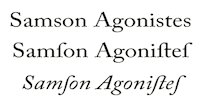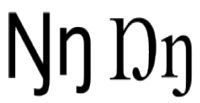12 Letters that Did Not make the American English Alphabet -Page 6

Long S
Sometimes the letter s will be replaced by a character that looks a bit like
an f. This is what's known as a "long s," which was an early form of a
lowercase s. And yet the modern lowercase s (then referred to as the "short s")
was still used according to a complicated set of rules (but most usually seen
at the end of a word), which led to many words (especially plurals) using both.
For example, the word superstitious would have been printed with ond used for
first and second s. The third s would be the standard short s.

Eng
For this particular letter, we can actually point to its exact origin. It was
invented by a scribe named Alexander Gill the Elder in the year 1619 and meant
to represent a velar nasal, which is found at the end of words like king, ring,
thing, etc.
Gill intended for the letter to take the place of ng entirely (thus bringing
would become briŋiŋ), and while it did get used by some scribes and
printers,
it never really took off - the Carolingian G was pretty well-established at that
time and the language was beginning to morph into Modern English, which
streamlined the alphabet instead of adding more to it.